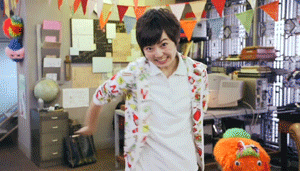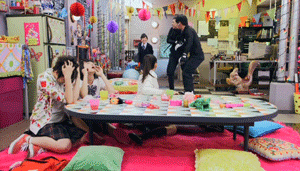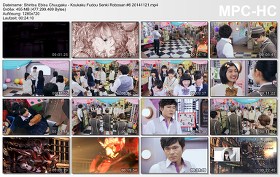[TV Drama] Koukaku Fudou Senki Robosan
-
Finally I was able to make Robosan ep.4 gif Recap:
Detective Yasumoto:
Spoiler:


aiai:
Spoiler:
Kaho:
Spoiler:

Riko:
Spoiler:


Ebichu's unmatched ability of hiding things:
Spoiler:

How to work under pressure:

My favorite scene (it was so out of nowhere):
http://invadermcz.tumblr.com/ -
Robosan #5:
http://www.nyaa.se/?page=view&tid=623542 -
Robosan ep. 5 gif Recap:
- Does anyone know why I do this instead of studying?
- I thought so, but oh well... next exam is about Japan, so watching Robosan more or less counts.
Mirei:
Spoiler:
Hinata, with special mentions to:
The moment she stole every heart in the room
The loving look she gave to Mirei
The moment she decided she'll kidnap Mirei
The moment she.... did this
And more
Spoiler:



Messing with people:
Spoiler:




Mayama brought snacks! (they don't appreciate you Mayama, bring them to me)
Spoiler:


Juding poor Mayama:

http://invadermcz.tumblr.com/ -
And already on HO as well :)
http://www.hello-online.org/index.php?app=xbt&CODE=details&torrent=80008

-
Ok -- it's time for a dumb (but probably necessary) question: Is that room inside the robot?
I've had the suspicion that it is, I wasn't sure, because the idea just seemed to silly. But after watching Episode 6, I kind of think it must be. At first, I thought it was inside the robot's head, but now I think it's in its stomach (or abdomen, or whatever), right behind that jewel-like thing that glows when it wakes up (and which seems to be the window/view-screen that they were looking at at one point in the episode).
If that is the case, it raises some major questions (some of which can't have any sane answers :)) ) And it also makes the room even more awesome than it already is! -
^ I was going to ask the same thing. I've always assumed they were inside the robot (without any explanation of how they get into it or why their parents let them walk into a war zone). I didn't understand why they got excited on episode 6, It looked like they've just found out they were inside the robot but I thought they already knew :-?
-
It seems like it would be kind of hard not to know, since they'd have to get into the robot from outside (and through the war zone), but it looks like that's what's going on. And that room! How did it get inside thr robot? or do all giant robots come with ultra-cute teenage hangout rooms? :))
But if it is inside the robot, then that kind of explains the 甲殻 in the show's name (and the robot's kind of bug-like antennae). If it's a crustacean robot, and if they're in it's middle, they they really are ebi chuu -- in the middle of a crustacean. I hope they meant it that way, because it's just too good! :)) -
Robosan ep. 6 gif recap:
Rina As always she appears out of nowhere and side-eyes everyone. We still haven't seen much of her on this show, she either judges from a distance, reads a book or threatens people. In my own particular version of Robosan she's an A.I. in charge of taking care of the girls.
Hinata: Once again winning the best smile award
And the reaction award
aiai: because I'm biased
Spoiler:




http://invadermcz.tumblr.com/ -
TotallyUncool said:
Is that room inside the robot?
The first episode starts with the professor asking the girls why they let themselves inside the robot, and why they're even in an restricted part of town. They say it's close to their homes and, really, isn't it great that students from different grades and schools have a meeting place? We even brought a fridge and games. Nobody was here anyway!
He calls it the main control room. It's the closest thing to a cockpit researches have found. I assume it happens to line up with a floor on the building behind, allowing access.
Anyway, I want more evil Rina. -
^Thanks for the information -- that helps, and somehow, it makes the whole concept even more wonderfully insane. :))
And thanks for the gifs, Invader!
"Oh, let's all hang out inside the control room of that giant combat robot in the middle of the battle zone! We'll just bring over a truckload of stuff and make ourselves at home!"
I have a spare refrigerator that's about the size of the one in their hangout. I had to move it from the garage into my kitchen recently because my main fridge had a problem, and now that I've fixed the main fridge, I'm kind of putting off moving the spare back into the garage, because even with a hand-truck, it's a lot of work. And that's just a short distance on level ground, with only two low steps. If they could transport their refrigerator through several blocks of smashed-up urban battle zone (while watching out for giant killer robots), up several flights of stairs in a half-ruined building (or however they got to the entryway into the robot), and down those metal steps into the control room, maybe they do have super-powers. It wouldn't surprise me at all! :))
I'll take more creepy Rina -- and lots of Aiai's crazy intensity. -
I've go maybe 25% comprehension of written Japanese, and much less with spoken Japanese, so I only catch a few phrases as I watch the show. I should replay short segments of the show and listen to the dialogue until I start to pick it up. I was doing that with the on-screen text in Ebichu Global -- stop, read through the text, check the unfamiliar kanji with a Japanese dictionary, then listen to what they were saying. It was good practice, and trying to pick my way through spoken dialogue without any on-screen text should be even better practice.
-
That's interesting -- I'll have to listen to members of all three groups talking, and see how much I can pick up from each.
Howdy, Stranger!
It looks like you're new here. If you want to get involved, click one of these buttons!
Categories
- All Discussions568
- MomoiroClover.net
- ↳ Announcement8
- ↳ Lounge5
- Momoiro Clover Z
- ↳ News and Releases134
- ↳ General Discussion83
- ↳ Media Center58
- ↳ Download Center30
- The Members
- ↳ Takagi Reni (高城れに)5
- ↳ Momota Kanako (百田夏菜子)5
- ↳ Ariyasu Momoka (有安杏果)4
- ↳ Tamai Shiori (玉井詩織)4
- ↳ Sasaki Ayaka (佐々木彩夏)7
- Stardust Section 3
- ↳ Shiritsu Ebisu Chuugaku85
- ↳ Team Shachi53
- ↳ Takoyaki Rainbow24
- ↳ Batten Show Jo Tai16
- ↳ Tokimeki Sendenbu18
- ↳ ukka (formerly Sakura Ebis)2
- ↳ B.O.L.T (formerly Rock A Japonica)11
- ↳ Hachimitsu Rocket3
- ↳ Iginari Tohoku San6
- ↳ Crown POP2
- ↳ Amefurasshi1
- ↳ Other Groups8
- General
- ↳ General Chat26










